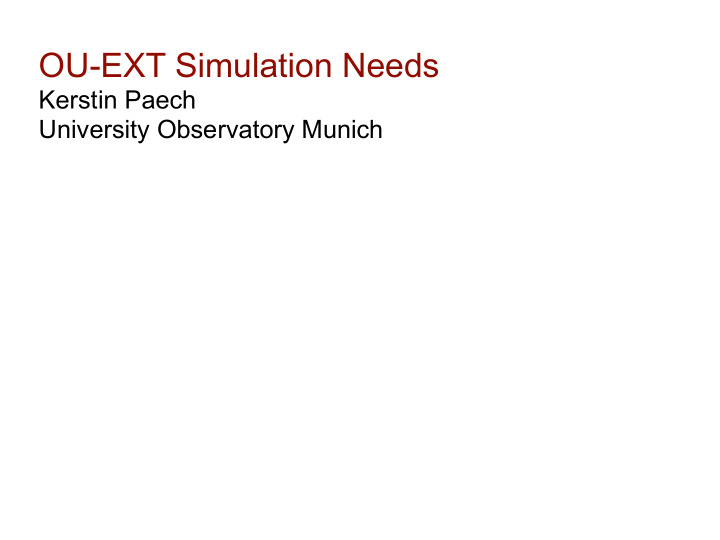



OU-EXT Simulation Needs Kerstin Paech University Observatory Munich
OU-EXT Simulation Needs Kerstin Paech University Observatory Munich External Data to be processed: North: PANSTARRS or HSC -- to be decided South: DES
Required Input Data - DES: DECam and its CCDs from Brenna Flaugher (Fermilab) 62 2kx4k fully depleted CCDs: ! DECam / Mosaic II QE comparison 520 Megapixels, 250 micron thick, 15 micron (0.27 � ) pixel size 100 90 12 2kx2k guide and focus chips ! 80 Excellent red sensitivity g r i z Y 70 ! Developed by LBNL 60 ! QE, LBNL (%) 50 Packaged and tested at FNAL QE, SITe (%) ! 40 Read-time <17 sec with <15e read 30 ! 20 noise 10 0 300 400 500 600 700 800 900 1000 1100 Wavelength (nm) 3 deg 2 active area Euclid Consortium Copenhagen - DES Overview - Mohr 16. May 2012 8
Required Input Data - DES: area ‣ 10 deg 2 for a start, 100-200 deg 2 better, overlapping with DES filters/depth ‣ (u)grizY 10 σ galaxy depth ~ 24 mag
Required Input Data - DES: pointing strategy ‣ 10x92 sec exposures in griz, 4x80sec in Y ‣ 2 or 3 filters per pointing • gr in dark time • izY in bright/day time seeing, airmass, sky • guidance from BCS/Mosaic2 (Desai et al. 2012) Y ~ 18.75 peak@ average average ~ 22.5, 21.5, ~ 0.85’’ ~ 0.14 20.5 18.75 for griz
Required Input Data - DES: data format and access ‣ fits files of raw exposures for download • exposure information (e.g. AIRMASS, SEEING, EXPTIME, RDNOISE,...) including WCS information (TAN or TPV projection) • preferably in one MEF • preferably HDU[0] should contain all the information that is the same for all CCDs(e.g. FILTER, INSTRUMENT,...) • preferably overscan region in column format data volume (for ~200 deg 2 ) ‣ 3 TB for 10 nights of observing • ~20 deg 2 (350 exposures of 600MB compressed) per night • about 290 science exposures and about 60 calibration exposures (bias + flats) catalogs/truth tables ‣ for astrometry ‣ photometric calibration ‣ all simulated objects
Required Input Data - DES: required for pipeline: ‣ crosstalk ‣ scattered light ‣ dome flats not necessary for DES (not dealt with in processing): ‣ persistent charge effect in DECam ‣ non-linearities ‣ dark noise
Miscellaneous - DES: Status/Plan Simulations: ‣ None (DECam simulator run by Huan Lin at FNAL) Framework: ‣ Use local data base for testing ‣ ingest image and catalog meta data, catalogs into EMA for next stage of processing Output (processing done at Munich): ‣ calibrated stacks (fits format) including weight and bad pixel masks, PSF homogenized ‣ calibrated single images for OU-MER testing ‣ calibrated catalogs (in fits format) ‣ QA meta data
Recommend
More recommend